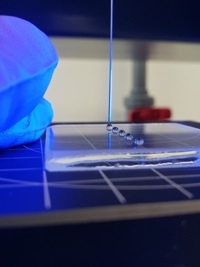The NSG Group and University of Cambridge are collaborating on ground-breaking new glass applications, while using the latest technology to realise the future of manufacturing.
The Group, which owns Pilkington United Kingdom Limited, is currently working with the University’s Fluids in Advanced Manufacturing team (FIAM) to establish a way of printing conductive materials onto wide areas of curved glass surfaces.
Currently, conductive materials can only be effectively printed onto flat glass surfaces. If successful, this innovation is set to enable the printing of metallic nano inks at high precision across curved glass, introducing new applications for glass in automotive and architectural sectors by increasing the potential functionality of glazing. New uses include helping detect pollution, incorporating heating elements or as digital signage.
The research aims to see the conductive materials applied to curved glass surfaces, such as car windscreens, using inkjet printing technology at the final stage of the manufacturing process. This process will help make high tech curved glass more cost effective to manufacture, while helping it to be increasingly customisable for customers – boosting its marketability.
For the first phase of the research, the partners are using virtual reality to model and design a laboratory that uses robotic technology to print the conductive materials onto curved glass surfaces. Using robots, printing the nano inks will be done with high precision and speed, while accounting for the curvature of the glass.
Dr Su Varma, R&D incubator academic programme director at the NSG Group European Technical Centre, said: “This is an exciting project that has the potential to extend the boundaries of glass’ use in car manufacturing and building design.
“It allows high-tech applications of glass to not be limited to flat surfaces, expanding opportunities for architects, while revolutionising the role that glass can play in vehicles.

“The project is our latest initiative working by the side of the University of Cambridge, a relationship that extends past the inauguration of the institution’s Pilkington prize in 1994, which recognises outstanding contributions made by academics and researchers to the University.”
Dr Ronan Daly, head of FIAM and senior lecturer at the University of Cambridge, said: “Smart technology applied to glass has the potential to perform a number of important tasks - from identifying the presence of bacteria on a hospital window to performing as a touchscreen display, for example.”
“Conductive materials can already be printed onto flat surfaces, and alongside the NSG Group we’re now overcoming the physical challenge of completing this for curved applications – this opens up new opportunities for designers to use glass technology to solve their modern design challenges.”
The pair are also co-funding a PhD student, James Macdonald, who is based at NSG Group’s European Technical Centre in Lancashire and at the Institute for Manufacturing, University of Cambridge, for researching new ways of patterning and printing on glass. Dr. Cristina Rodriguez-Rivero from the Institute for Manufacturing is leading the printing-to-shape research.